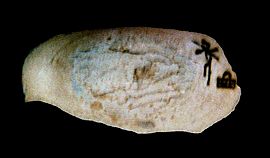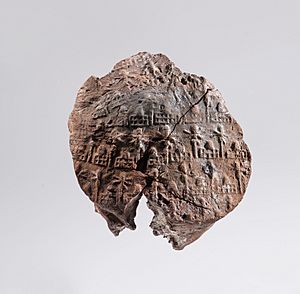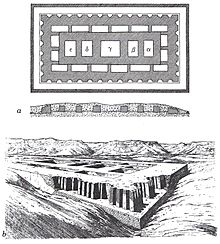Neithhotep facts for kids
Quick facts for kids Neithhotep in hieroglyphs |
|||
|---|---|---|---|
Personal name:
Neith-hotep/Hotep-Neith nt-ḥtp "Neith is merciful" |
|||
| Alabaster fragment with the name of queen Neith-hotep. | |||
Template:TOC limit=3 Neithhotep or Neith-hotep was an important ancient Egyptian queen who lived during the early First Dynasty. For a long time, experts thought she might have been a male ruler. This was because her tomb was very large, and her name appeared in a special royal symbol called a serekh.
Later, as people understood ancient Egyptian writing better, they realized Neithhotep was a powerful woman. She was first thought to be the wife of Narmer, Egypt's first pharaoh, and the mother of Hor-Aha. Newer discoveries suggest she might have been Hor-Aha's wife instead. She might also have been the mother and co-ruler of the next pharaoh, Djer. Some evidence even suggests she ruled Egypt as a pharaoh herself. If this is true, she would be the earliest known female ruler in history!
Contents
Who Was Neithhotep?
Her Name and What It Means
Neithhotep's name is linked to Neith, an Egyptian goddess of war and hunting. It was common for queens and princesses during the First Dynasty to have names connected to this goddess. Other queens like Merneith (who might also have been a female pharaoh) also had names like this.
Her Important Titles
As a queen, Neithhotep had several important titles. These showed her high status:
- Foremost of the Women (Khenty wat)
- Consort of the Two Ladies (Semat Nebty)
It's possible Neithhotep had even more royal titles. However, they haven't been found yet. During her time, many royal titles for kings and queens were still new. Ancient Egyptians might not have known how to write all of them yet. Also, the role of queens might have been different back then.
Where We Found Her Name
Neithhotep's name has been found in several places in Egypt. These include Helwan, Abydos, and Naqada. Her name appears on clay seals, ivory tags, and stone bowls. Most of these items were found in her tomb or in the tombs of Hor-Aha and Djer. On some clay seals, Neithhotep's name was written inside a double serekh. This is a special symbol usually used for kings.
New Discoveries in the Desert
Recently, Neithhotep's name was found in the Wadi Ameyra in the Sinai Peninsula. This area has rock carvings from kings like Iry-Hor, Narmer, Djer, and Nebra. One carving from King Djer shows royal boats and his serekh. Neithhotep's name is carved diagonally above Djer's serekh.
Why Neithhotep Was So Important
Early Ideas About Her
When Neithhotep's tomb was first found, people thought she was a male ruler. Her tomb was huge, and her name was in a royal serekh on many seals. This made experts believe she was an unknown king. But as they learned more about ancient Egyptian writing, they realized she was a very high-ranking woman. Because of this, they then thought she was the wife of King Narmer and mother of Hor-Aha. This idea came from clay seals in her tomb that showed the serekhs of Narmer and Aha.
Evidence for Her Power
Neithhotep's name appears inside a serekh on several clay seals. This was usually only done for male rulers. Also, her tomb is incredibly large and has its own special area for religious ceremonies. Only Queen Meritneith, another powerful queen, had a similar tomb.
The carvings in the Wadi Ameyra also show Neithhotep organized an expedition there. This trip was to mine valuable materials. Ordering such an expedition usually required royal power that a regular queen didn't have. This suggests she might have been an independent ruler.
Like Queen Meritneith
Neithhotep's story is very similar to that of Queen Meritneith. Meritneith ruled Egypt when her son, King Hor Den, was too young. This has led experts to believe that Neithhotep might have also ruled for a child king. This kind of "substitute" rule was common in early Egyptian times. In fact, early Egyptian dynasties were often started by royal mothers, not just passed from father to son.
Was She King Teti?
Some scholars even think Neithhotep might be the mysterious King Teti. This king is mentioned in later Egyptian lists and on the famous Palermo Stone. The Palermo Stone shows a gap in time between King Hor-Aha and Djer. This gap is about one year, one month, and 15 days. This short time seems too brief for a full king. It fits better with someone who ruled as a temporary leader. Since we know Neithhotep likely ruled temporarily, this gap might refer to her time as ruler. This would also explain why no other items from the First Dynasty mention a king named Teti.
However, not everyone agrees that Neithhotep was King Teti. Experts like Werner Kaiser and Walter B. Emery point to clay seals found in the tombs of Den and Meritneith. These seals list all kings from Narmer to Den. They always start with Narmer, who was Neithhotep's husband. Kaiser and Emery believe this shows Narmer started the First Dynasty. Kaiser also notes seals that mention the name Menj next to Narmer's serekh. This means Narmer might be the same person as King Menes. If so, the name "Teti" might belong to Hor-Aha, not Queen Neithhotep.
Her Tomb
Neithhotep's tomb was found in 1897 by a French archaeologist named Jacques de Morgan at Naqada. He spent only 15 days digging there. A German archaeologist, Ludwig Borchardt, looked at the tomb again in 1898. Later, John Garstang re-dug the tomb in 1904. He found hundreds of items left behind from the earlier digs. About 200 of these items are now in the Garstang Museum at the University of Liverpool.
The tomb was a huge mastaba, a type of ancient Egyptian tomb made of hardened mudbricks. Its outer walls had special carved niches. Today, the tomb is completely destroyed due to weather and time. Because it was so big, people once thought it belonged to King Menes. The location of the tomb might mean Neithhotep had connections to the powerful leaders in Naqada. This is different from the old idea that she came from Lower Egypt. It was once thought that Neithhotep married Narmer to help him unite Egypt.
See also
 In Spanish: Neithotep para niños
In Spanish: Neithotep para niños




